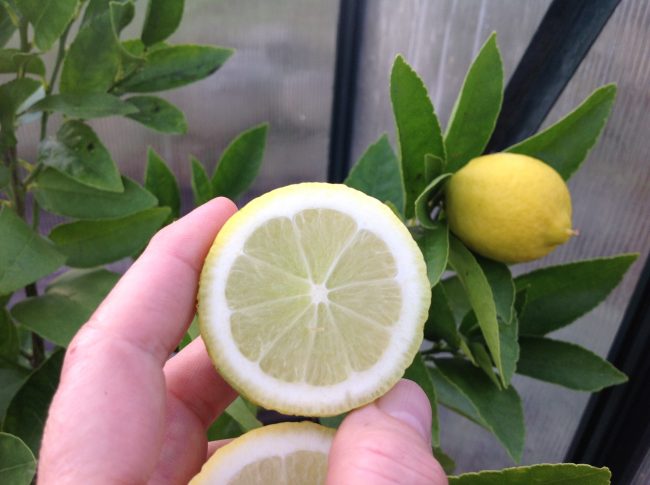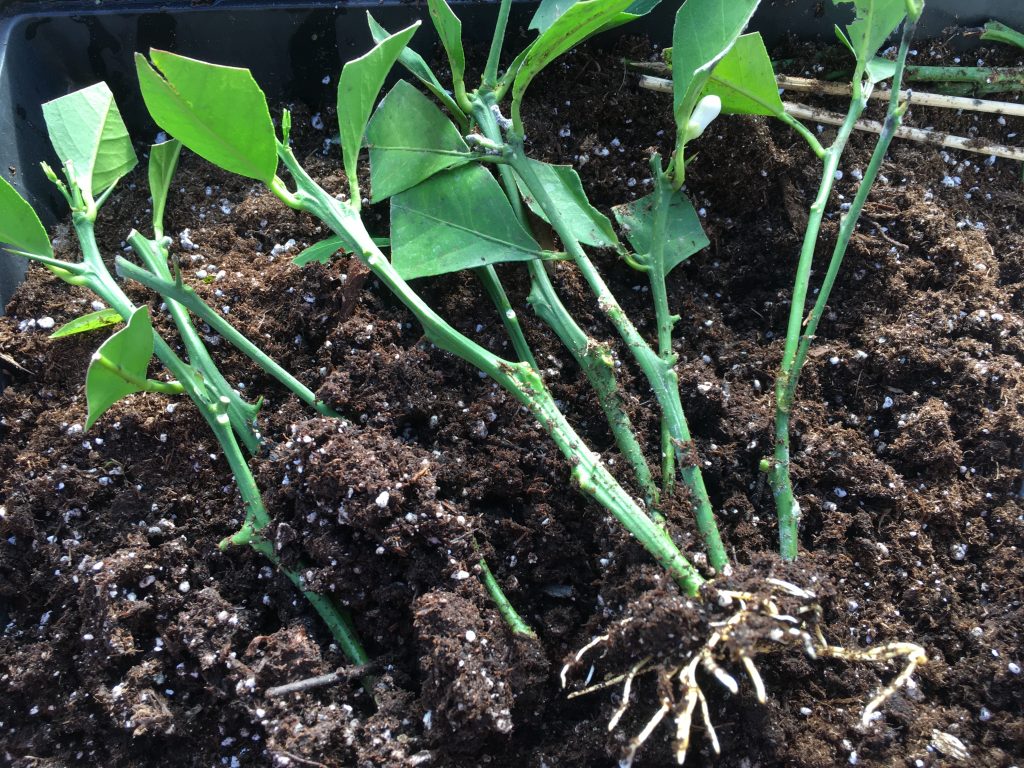
I help gardeners grow
& beginners blossom.
No seed left behind,
no soil unturned.
Together we can have lots of fun growing
great gardens using simple practical tips.
- Featured in -





Start saving & storing your garden seeds for a more more sustainable future
SIGN UP to get the FREE Seed packet PDF
X CLOSE

How Do You Get Lemon Trees Through Winter?
First the good news. Lemons trees can freeze and they won’t die. Now the bad news. If you bring a lemon tree indoors after it gets a chill outside it will most likely lose all its leaves. Huge temperature swings cause stress and a massive change in humidity from a chilly +5 C exterior to a dry +21 interior is just too big. Your lemon will definitely drop it’s leaves as Louise mentions in her email below:
I have a Meyer lemon that I have just moved indoors after that first frost dropped many of its leaves. It is currently in the 5 gallon plastic pot I received it. Seems to me you told me I should be putting it in a grow bag and then in a water tub. Wondering if you still have large grow bags available and also where I would get the tub. Let me know if you have one or either for sale.
Louise

Lemons bloom sweetly and bear fruit year-round. Ripening lemons can be left on the tree until you feel like picking them. The truth is the plant can tolerate a real chill down to -6 C but the fruits freeze at -2.5 C. If you are bringing a lemon through winter outside pick the large fruits before you tuck them away just in case something goes wrong!
Louise asks a good question. First she wants to know what is happening to her small tree. It is obviously responding to the big swing in temperature and dropped its leaves when she brought it indoors. The good news is the tree will likely rebound and grow all new leaves in spring. The bad news is that a plastic pot might keep the roots too wet and they might rot instead of rallying to bring the plant back into leaf and bloom.

Bob Duncan, Fruit Trees and More, has grown lemons outdoors for over twenty years and he was my inspiration to give it a try.
This is why Bob Duncan, of Fruit Trees and More, in Saanich BC suggests keeping lemons dry over winter. In his “Winterizing Lemons” newsletter he wants Meyer lemon growers on the coast to get their plants out of the rain so the soil doesn’t get soggy. The same applies to lemons growing indoors in colder climates. Reduce winter watering drastically and give the plants a way to breathe. Traditional pots like unglazed Terra cotta clay are perfect for breathing. So are fabric bags because there is great air exchange between soil and environment.
I grow lemons in raised covered beds and in root pouches (the fabric bas Louise alludes to in her note.) These allow the extra water to evaporate from the root ball. So instead of just keeping them dry, I also give the roots a way to breathe. (I sell them on my web page so if you need a few for your garden or lemons go HERE.) Fabric bags are ideal for all kinds of crops including root crops like potatoes and lemons and they are a lot lighter and cheaper than Terra Cotta.

This little lemon tree was bought this spring, moved into a root pouch (a fabric bag made of recycled plastic) and now has over 20 lemons with blooms still coming. I will be moving it into my lemon house shortly but will keep it in the grow bag for at least another year.
The tub Lousie refers to is just a plant saucer readily available at all garden centres and big box stores so they are easy to find locally. Place a saucer under your pot and make sure they are not making contact with a painted or wood surface indoors because somehow the humidity always moves and I have ruined a good surface or two along the way. If the tree is quite big you might want to place the saucer over a wheeled plant dolly available online or at your local garden centre.
My winter lemon house is a pretty simple solution. Helpful Husband designed it to face south so it heats up naturally even though it is outside. Initially, when the trees were small we simply wrapped them in Christmas lights and Agribon fabric. Last year we added a hanging frame to hold the row cover so it doesn’t cling right to the plants directly. We plug in the Christmas lights to a thermostat so it turns the lights on automatically when the outside temperature dips below +2 C.

When our trees were small we wrapped them in Christmas lights and fabric to keep them cozy when temperatures dipped below +2 C.

As our trees grow it is harder to wrap trees individually so Helpful Husband designed a frame to allow us to hang the fabric down and around the plants. We close the ends of the fabric with clips to keep it cozy. We will be installing the fabric by mid-November even though temperatures on the west coast will not dip below zero until later. We want to be ready.

Layers of winter-weight Agribon hang from the newly built frame over my lemon trees last fall. Under the Agribon I have installed my old school 7 watt Christmas lights and they are attached to a thermostat so the lights turn on automatically when temperatures dip to +2 C. We never water the trees in the winter but we do trim them heavily before they go under cover so they are smaller and more compact.
Just a few weeks ago, when I was prepping the lemons for winter storage I trimmed the plants back so they go into winter slightly more compact. And then because I hate to waste anything I dipped the cuttings into Stim-root #3 rooting powder. This powder triggers root formation on woody stems. Then I cut back most of the leaves and even trimmed the two eaves I left on each stem in half. I plunged ten cuttings per four-inch pot full of damp pro-mix and then place ten pots of cuttings on a heat mat to help them root. I stretched a dry-cleaning bag over the tray filled with cuttings to hold moisture and humidity in and I waited. In two weeks there was nothing to report but in less than three weeks, stems pulled from their soil have small roots. Yay! Next year I will have forty, fifty or maybe even 100 lemon trees. Umm – even I don’t make that much lemon pie!

Lemon twigs under their dry-cleaning bag and over heat have started rooting in less than three weeks. I could have up to 100 new trees by next spring!

In less than a month my tiny lemon cuttings are rooting! So I potted over 80 little plants into their own 9 cm pots and placed them on my heat mat and covered right away with plastic to keep humidity in.
So to recap:
INDOOR GROWING – If you are growing in a cool climate like Louise, bring your lemons indoors before outdoor temperatures drop too much. Find your trees a spot like an unheated front porch where it is bright but cool. Some people have a window in a garage where the temperature stays just at or above freezing and this will also work. Water very little lightly over winter but mist leaves with water to discourage indoor plant pests like spider mites. If you have to keep the plants in a warmer spot make sure your other house plants are far away because lemons are prone to getting mites indoors and these will spread from your jeans or your dog’s fur to the rest of your house.
Avoid fertilizing until light levels jump in May or June. Flowers in May will produce good sized lemons by October. Even some of the cuttings I took in early October are already in bloom so these Meyer lemons want to succeed! In spring I will move each little rooted cutting up to a one-gallon fabric bag.
OUTDOOR GROWING – If you are bringing your lemons through the winter in an outdoor area because – like me – you garden in a milder coastal climate, make sure the soil is out of the rain and well drained. Cover your small trees with old-school Christmas lights (7 watt bulbs) that give off heat. Bob says you’ll need 7-10 bulbs for a small 2′ by 2′ tree. I use a whole string for each of my bigger 7′ tall x 5′ wide trees. I have them plugged into a thermostat that turns on the lights when it is just above zero. I cover my trees by early November and uncover in early May to keep them warm as long as possible.
In summer I keep the soil in the raised beds fairly dry but I hose down the plants weekly to discourage pests like spider mites. I fertilize in spring with the same organic fertilizer I use for all my food and flowers (Biofert Organic Blend 6-2-7).
Lemons can be left on the tree until you are ready to eat them. They turn yellow when ripe but this fall I have been eating and juicing lemons that are still green because they are full size and they are starting to yellow which means they are ready to eat. PS I also grow Bears Lime under my winter cover outside and their fruit also turns yellow when it is ripe but I like my limes green so I pick them early.
Donna Balzer is the Brand Ambassador for BCGreenhouse Builders and she has two greenhouses in her big backyard.

What Would Donna Do?
Get my growing and gardening tips and pointers throughout the season.
















Okay Good! Glad this helped. Looking forward to hearing from you again and maybe seeing you in class. I also suggest epson salts (10 ml tsp per Litre water) every two months if leaves are pale or partially pale. And yes, I use my fingernail and scape off the scales as I find them and also wash the leaves with soapy water. It is a passion project but once they are outside the beneficial bugs do all the work! Jealous about that lemon! Are you signed up as a follower of mine? If so you will be the first to hear when we get new classes organized. (Another passion project)
Hi Donna,
Thank you for kindly taking the time to reply, it’s really helpful! I have taken it into the garage where it is now by a window and this coming week I will replace the soil and move it into a fabric pot with some perlite.
Would you treat it for the scale insects with insecticide or just see if it sorts itself out when back outside?
It’s not looking too bad now, I’ve pruned the yellow leaves, most still look healthy.
I found the Sicilian lemon in a deli, I couldn’t believe the size of it and the seeds too! I am rubbish with cuttings for some reason, they never take – the seeds were pretty challenging, I peeled them and germinated them in a warm dark cupboard – it took weeks, I wasn’t really expecting any to work but since one finally did, I can’t give up on it now!
Thanks again – and yes I’d love to join your class in Autumn, if time differences allow 🙂
Chrissie
Hi Chrissie
I am assuming the UK is pretty similar to Vancouver Island and I grew lemons there outdoors for 10 years so I hope I can help. First, it often takes 8-10 years to get flowers and fruit on lemons grown from seed, and just as an aside I am so jealous that you have seeds from a Sicilian lemon! Cuttings are much faster to fruit- in as little as one year because the hormones on the plant are triggering a blooming response from the mature wood.
On these “border-line” coastal climates lemons can grow outdoors if protected a bit from cold and rain (I designed the overhead structure shown in my online class) so that the heat would rise up and circulate down. This also keeps the rain from landing right on the otherwise excessively wet soil.The biggest killer of heat-loving lemons is overwatering. This causes leaf wilt and root dieback. I also cover outdoor trees with Agribon 50 over winter to keep heat in. Bottom line is lemons do better when it is colder and drier over winter (even in a garage or unheated shed with a window?) because that also slows down insect reproduction. Typically outdoor lemons are in terra cotta pots but I used the fabric pots because they are a lot lighter than terra cotta but do the same job. As I get older I appreciate the lighter weight pots! Lemons do need to dry out so if there is an overhang on your home or shed or if there is a space in a garage, you should move your pot. Lemons prefer a south facing aspect. You could also choose to remove your plants from their pots and mix a new batch of soil that drains faster but the first thing you need to do is get them out from the open rain zone and get them some cover to stop future rain landing on soil. This way the soil will dry out a bit as days get brighter. We do answer all these questions in our online masterclass. I would suggest you take the live class because it is so much fun and interactive so you can also learn from other participants, but we don’t offer lemon camps again until fall. In the meantime google Food Garden Life Masterclass because it is a pre-taped version. And also about bugs- I noticed my trees outside that were in raised beds or root bags never had problems with fungus gnats or scales so as a result there were no ants. There is obviously a beneficial bug that takes care of these when they are growing outside and I assume it is a wasp because I often saw wasps on my mature plants. I never saw a single scale on my outdoor plants. Step one, move plants to protect from overhead rain.Step 2 repot and use a very dry mix (maybe up to 50% perlite) and step three, when you do change pots and soil, cut away any rotting roots.Plants may spring back. Hope to see you in our masterclass!
Hi Donna,
I am in the UK and grew an impressive sized lemon plant (now a small tree) from a seed taken from a sicilian lemon. It is about four years old now and still to bloom but I’m being patient!
I kept it indoors mostly but it got terrible pests – fungus gnats in the soil, scaly bugs on the leaves and stems and then ants, attracted to the honeydew. I was so fed up of the insects in my house so temporarily I put the plant outside (mid March).
There has been no frost since them, temperatures have dipped to about 3 or 4° but it’s looking quite sad and it’s probably getting way too much water as we’ve had torrential rain many days. The leaves are drooping and looking quite pale. It’s in a large plastic pot.
How can I rescue it? Should I repot it in a root bag and bring it back inside? And if I do that, will I get leaf recovery pretty soon? I regret putting it outside but the bugs were getting ridiculous 🙁
Thanks for your advice!
Well very little water actually, because there is a chance roots will rot if the lemon is too wet. However I let my plant physically wilt after not watering it for 6 weeks and that is not good either. Keep an eye on it and when it feels dry add water. But do not soak plant too liberally. If your lemon is in a very hot space it will need more water than if it is growing in a cool space. Also, you should watch for the details of our lemon workshop coming up March 25. If you get my newsletter it will be announced there!
How much water is enough for lemon tree o er winter indoors?
Ahh- good question. Spider mites live on many plants and we just don’t notice them because there are predators that take care of them in an outdoor environment. Once inside spider mites can spread from plant to plant just by hitching a ride on your clothes or your dog’s fur. Some plants, like ferns and lemons and green beans seem to be more attractive to these mites. It is true they overwinter on our ledges and windowsills in tiny cracks but even if you think they are all gone they can reappear in March when day length gets longer.
Hi Donna;
” …mist leaves with water to discourage indoor plant pests like spider mites.”
Where do these spider mites come from??